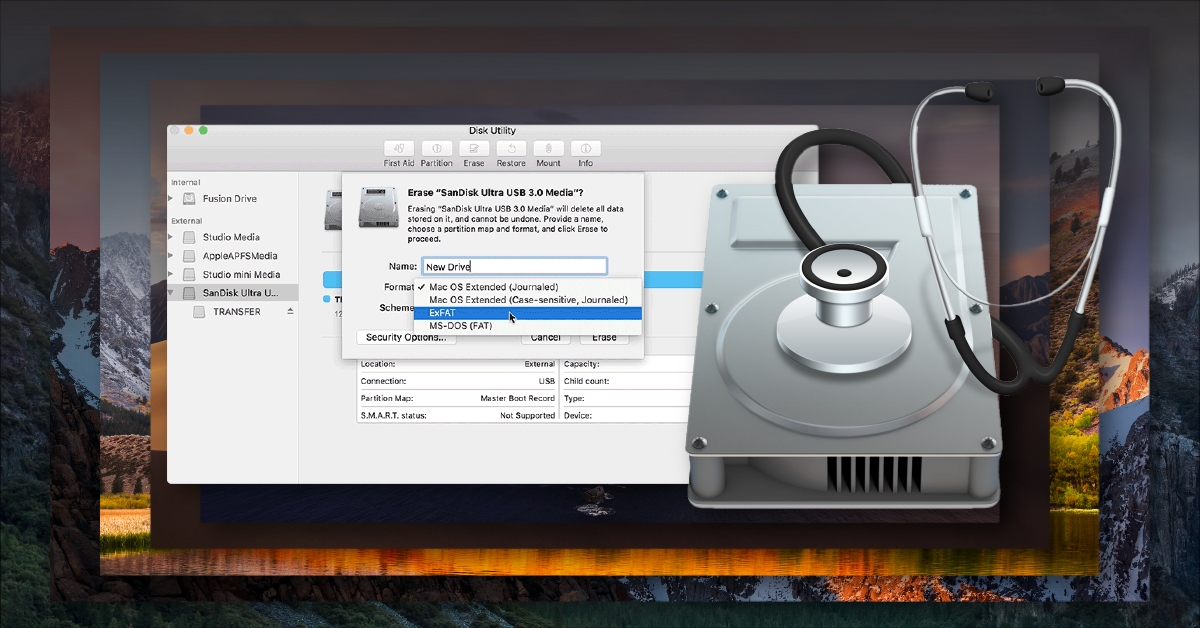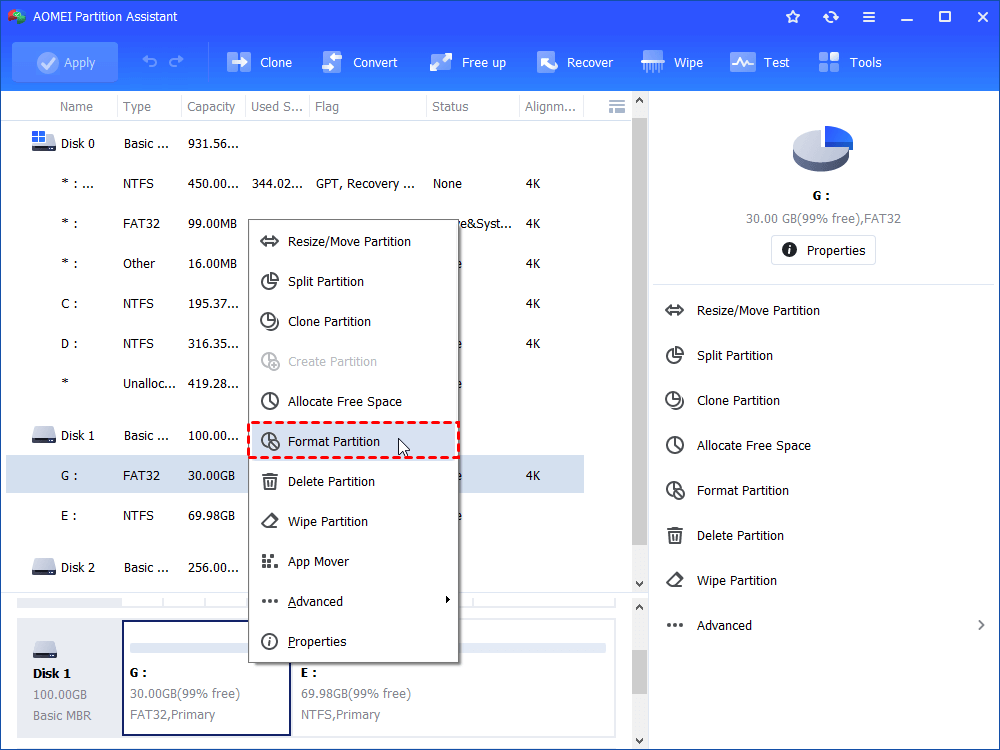This simple guide will teach you How to Format a Flash Drive on Mac. Not only this, we will help you pick the best file system for your usb flash drive that you are planning to use on a Mac.
How do I format a flash drive to NTFS on a Mac? MacOS supports NTFS, but read-only. In order to write or format NTFS, you need a third party app. Paragon & Tuxera have solutions to do this. I needed to perform an offline system update for Xbox One S but I only have Macs. Installed the Paragon NTFS for Mac using 10 day trial. That allowed me to format a USB drive as NTFS with full read-write access and then write the system update files to the USB drive. Offline Xbox update worked like a charm via USB stick. – Brian D Dec 2 '19. Jul 05, 2017 To format a drive on a Mac, you’ll need the built-in Disk Utility application. Press Command+Space to open the Spotlight search dialog, type “Disk Utility”, and press “Enter” to launch the app. You can also open a Finder window, select “Applications” in the sidebar, and head to Utilities Disk Utility. How to format usb flash on mac or how to format hard disk on mac with best free usb drive formatting software download for mac or HP USB Disk Storage Format Tool mac edition download and free hard disk format tool mac to format usb flash drive fat32 on mac os or to create bootable usb or format usb in mac.
Majority of 49.4% of desktop and laptop computer users in the world use Windows operating system. In contrast, only 27.4% of users use MacOS, obviously for their apple computer. That’s the reason why most of the flash drives in the market are available in Fat32 or NTFS formats which are the most preferred format for windows.
Although the first one, Fat32 is completely compatible with both MacOS as well as Windows, it has some limitations. Fat32 can store files only up to 4 GB of size. The latter one, NTFS is mostly used on the Windows operating system and not an optimal option for MacOS. Extra work is needed to use NTFS on MacOS. If you want to use your flash drive solely for MacOS, it is highly recommended to format your flash drive.
Here, pop-ups the question: How to format a flash drive on a mac?
Contents
- 1 Before you format a flash drive
- 1.1 Check flash Drive’s File System
- 2 How to format a flash drive on Mac?
Before you format a flash drive
MacOS supports HFS plus file system. HFS stands for Hierarchical File System.
Apple introduced this file system in 1985 to replace the existing Macintosh File System or MFS. HFS filesystem is modified into HFS plus (Modernly called as MacOS Extended). Before you format a flash drive it is suggested to know what file system your flash drive is in.
Check flash Drive’s File System
You don’t need to do anything special to know your flash drive’s file system. There are 2 ways you can do this.
Method 1: Using Finder
Plug in your flash drive. Now open the Finder and look for your USB device. Then right-click on the drive’s name. Select “Get Info” from the list of options opened.
A new window will open. Just to the right of “Format” is your drive’s file system.
Method 2: Using Disk utility app
Open the Disk Utility app from the utility folder available in the application. Your drive will be on the left column of the window. Click on the partition. Here you can check the current format of your flash drive.
If your flash drive’s file system is MS-DOS or ExFAT you can use it as it is without further formatting. But if it is NTFS, format your flash drive to make it completely compatible with MacOS.
How to format a flash drive on Mac?
Disk Utility application in MacOS is the best option to format a flash drive on MacOS. You can launch this app in two ways.
Step 1: Press Space while holding your command button. A search box will open. Type Disk Utility in the search box and press enter. Alternatively, Open the Finder window and select applications on the left sidebar. Navigate to Utilities and then Disk Utilities.
Step 2: Search for your flash drive on the sidebar of the Disk Utility app and select it by clicking on its name.
Step 3: Now Click the “Erase” button which is located just below the title bar of the window which says “Disk Utility”. This will erase your whole drive and make it a single partition.
Here you can change the name of your USB drive if you wish. This name will be visible on other devices as well if you plug your flash drive into them. Just below the Name section, you can see a section called “Format”.

You will need to choose a format option to change your flash drive’s file system. But which format to choose is the big question now! No need to worry. Read the description of each format given below and choose the format of your choice.
Types of filesystems
Mac OS Extended (Journaled)
This format is considered as default file system format of the Mac OS X drives. It also supports OS X Lion, like Versions. This format will allow you to use your flash drive on Mac without any limitations.
With Mac OS Extended (Journaled) format, you can setup OS X startup drive. Make sure you have right files and know how to do it. If you have any issues with a built-in drive you can boot from the external disk. This file system format is highly recommended for MacOS. But you cannot write this flash drive from windows PC once you have formatted it as Mac OS Extended (Journaled). You can read files though.
OS X Extended (Case-sensitive, Journaled)
Go for this type of filesystem if you really need it for some reason. For OS X Extended (Case-sensitive, Journaled), the word “File” is different than “file”. It means it’s case sensitive as the name suggests.
OS X Extended (Case-sensitive, Journaled, Encrypted)
Same as filesystem just mentioned above but of course with encryption.
OS X Extended (Journaled, Encrypted)
To use a flash drive with this filesystem you will have to set up a password & enter it whenever you plug in your drive into any device.
MS-DOS (FAT)
This is just a name for the FAT32 filesystem in Disk Utility application. FAT32 supports to almost all of the operating systems in the world. This allows you to transfer files from one operating system to other. The best thing about this filesystem is its support to video game systems which include Xbox 360 and PlayStation. This filesystem can be called a universal system. The limitation about FAT32 filesystem is it doesn’t allow files which are bigger than 4 GB in size and also you cannot create a startup drive unlike Mac OS Extended (Journaled).
ExFAT
This is a new type of filesystem and it supports MacOS X 10.6.5 and later. It is same as FAT32 but it supports files larger than 4 GB. As this filesystem is relatively new, it does not on relatively older versions of Mac OS X. If you don’t use any older version of the operating system, you can use this type of filesystem.
Use ExFAT for this tutorial if you wish to use your flash drive on windows as well on MacOS.
Step 4: For this tutorial, you can ignore the Scheme option which we use if you wish to boot from your flash drive. Click on erase button to format your flash drive.
Voila! You have formatted your flash drive now. You can eject drive by right-clicking on its name in the left sidebar and click on “Eject”.
Suggested article: How to Reset SMC on Mac?
I hope this article has helped. If you are still facing problems or have doubts on how to format USB drive on Mac, then simply comment below.

Related Posts:
Sharing data between a Mac running macOS or OS X and PCs running Windows may not be that straightforward. By default, Macs can only read files from Windows-formatted external hard drives, but not write to them. This prevents you from saving, editing, copying, or deleting anything stored on your drives using your Mac. The reason behind this? The file system used by Macs (HFS+) is different than the file system used in Windows (NTFS).
How to read NTFS files on a Mac

There’s a real easy solution for this, however: your Mac just needs a driver. Tuxera NTFS for Mac is a full read-write NTFS driver that enables your Mac to read and write NTFS-formatted drives. It also comes with Tuxera Disk Manager, a companion app that lets you format, check, and repair NTFS drives. Tuxera Disk Manager lets you fully manage your hard drive and stored data regardless of the operating system.
Formatting drives with Tuxera Disk Manager
Format Usb Flash Drive Ntfs Mac Software
You may find that you first need to format the external drive so it can be used with both your Mac and your PC. Formatting is the process of preparing a drive for use by an operating system. For reference, we explain in more detail what formatting is and why you need it here: http://www.tuxera.com/formatting-an-ntfs-drive-using-a-mac/
Format To Ntfs Mac
Here’s how you format a drive using Tuxera Disk Manager:
About Tuxera NTFS for Mac
Tuxera NTFS for Mac and Tuxera Disk Manager work in the latest macOS and OS X 10.11 El Capitan. It’s backwards compatible and runs on all OS X versions starting from Tiger. Personal licensing allows you to install Tuxera NTFS for Mac on all your home computers with a single license.